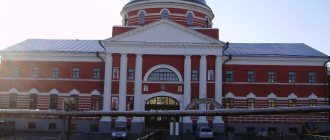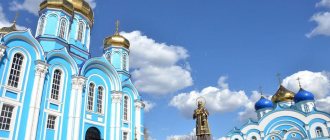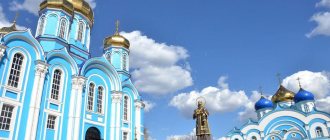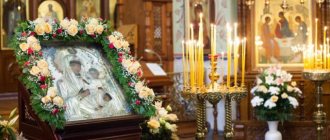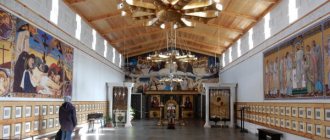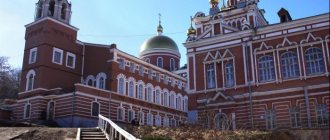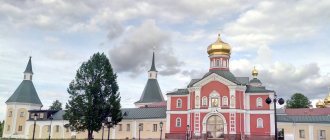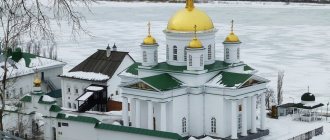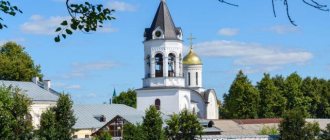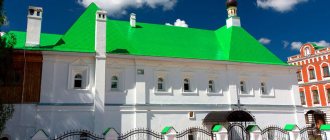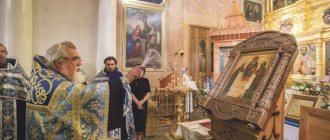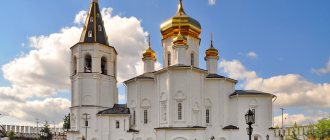Valdai Iversky Monastery
The Valdai Iversky Monastery is famous for the miraculous icon preserved in the Assumption Cathedral, as well as the gilded domes of this Orthodox church. The place for the monastery was chosen by the reformer of Russian Orthodoxy, Patriarch Nikon, when he was Metropolitan of Novgorod. The picturesque Selvitsky Island on Lake Valdai, named St. Nikon, became the site of the construction of one of three monasteries founded by this primate of the Russian Orthodox Church.
The model for the construction of the monastery on Lake Valdai, or the Holy Lake, was the Greek Iversky Monastery on Mount Athos, and its full name sounds like the Valdai Iversky Svyatoozersky Bogoroditsky Monastery. They decided to place it on an island in the center of the lake.
Selvitsky Island in the southern part has an artificial connection with the largest island of the reservoir - Ryabinov, which in a similar way communicates with the mainland shore. On the western shore of the island, a monastery boat dock was built, near which the Holy Gate of the main entrance was located.
The foundation of the monastery took place in 1653, after the approval of the plan by Tsar Alexei Mikhailovich Romanov, who allocated funding from the state treasury. The consecration of the completed stone Assumption Cathedral took place at the end of 1656 personally by Patriarch Nikon.
The less than fifteen years of his patriarchate were full of many innovations - church books and icons were brought into conformity with the Greek canons, bows from the waist and the sign of the cross with three fingers were introduced. All this led to a split among believers and the emergence of Old Believers.
Nikon sought equal participation of the church in governing the state with the tsar, which was decisively rejected by Alexei Mikhailovich, and the patriarch was subjected to disgrace, and then deposition with subsequent exile.
The general view of the Iversky Monastery on the Selvitsky Island of Valdai, or Holy Lake, has been preserved from earlier times. A man-made isthmus with a bridge connects it with the neighboring Ryabinov Island, and that with the mainland.
The remaining buildings of the Valdai Iversky Monastery were built later than the Assumption Cathedral, as was the fortress wall enclosing the monastery, with a total length of more than a kilometer. The contour of the walls almost followed the outlines of Selvitsky Island, separating almost 6 hectares of its territory.
The glacial origin of the reservoir determines the almost complete absence of current, calm water surface and abundance of coastal vegetation.
In the current appearance of the monastery one can see a convenient entrance from the south side, parking for tourist buses and a separate car park for the monastery brethren and clergy. The island's territory is almost devoid of vegetation, except for the western and part of the northern shore. The glacial origin of the reservoir determines the almost complete absence of current, calm water surface and abundance of coastal vegetation.
According to Orthodox canons, the main entrance to the monastery territory is located on the western side. The Holy Gate is made in the form of an arched passage in a two-story building, the upper tier of which is the gateway church of St. Philip. He is famous for his service in the Solovetsky Monastery as abbot, and then for his service as Moscow metropolitan.
Philip protested against the cruel methods of rule of Ivan the Terrible, for which he was removed from office and secretly executed by the tsar's henchman Malyuta Skuratov. Canonized by the Orthodox Church on the eve of the start of construction of the Iversky Monastery, the gate temple was named in his honor.
The central volume of the church is covered with four gable roofs with a spherical vault between them. On the vault there is an octagonal drum and a dome crowning it - a dome with a cross. The left wing is a staircase; the right wing on the first floor is a church shop.
The adjacent one-story buildings house residential monastic cells. Above the entrance arch there is a copy of the icon of the Iveron Mother of God - the Gatekeeper, or Goalkeeper.
It so happened historically that the Valdai Iversky Monastery has two Holy Gates, built in an earlier period and found themselves inside the territory. Between both entrance structures there is a tiled path with lanterns along it.
The second arched entrance is built in a massive rectangular building, on the roof of which is built the Church of the Archangel Michael, the leader (archangel) of the heavenly forces in the fight against the devil. The gate temple has a relatively small square base with an octagonal turret on the roof, on which there is a blank drum with a dome and a cross.
Premises for various purposes are attached to the gate on both sides; the entire building forms a transverse dividing line between the western and eastern parts of the monastery territory.
One of the vitally important buildings on the territory of the monastery was the refectory, built in an ensemble with the Church of the Epiphany immediately next to the Assumption Cathedral. To conduct divine services in winter, a warm church was necessary; Nikon himself ordered it to be provided in the monastery complex.
The building is built on two floors, with utility and storage rooms located below, and a refectory on the second floor. The front porch on the west side consists of a canopied staircase, parallel to the wall and fenced on the outside, with arched openings in the fence. The southern porch is decorated with faceted columns supporting the shelter portal.
Adjacent to the refectory on the eastern side is the Church of the Epiphany - a single-domed temple with a square lower tier and a tower of 8 sides with window openings, a blind drum on a hemispherical roof, and a dome with a cross on top. The decorations around the window openings - stylized kokoshniks and double arches above the windows, like some other elements, are made in red, contrasting with the whiteness of the walls.
The three-tiered tented bell tower of the Valdai Iversky Monastery is combined on a single base with the abbot’s building for the residence of senior clergy. The buildings stretch along the southern monastery wall. The square of the second tier goes into the octagon of the belfry, on the wall of which there is a clock.
Every 15 minutes the bells sound a chime that can be heard throughout the island. The bell tower is crowned with a tent in the shape of a sharp octagonal pyramid with dormer windows (chandeliers) on each side, a blind drum at the top and a dome with a cross.
The rectory has two residential floors and a basement; a distinctive feature of this building is the tiled decoration of the window openings.
The main and oldest building of the Iversky Monastery is the cathedral, first named after the miraculous icon, then renamed the Assumption Cathedral and acquired its original name in the new millennium. A feature of the temple architecture of the Nikon era is a covered gallery on all sides of the building.
The main (western) entrance to the cathedral is designed as a small chapel, the side chapels have two floors and double-sided staircases to enter them. The building, rectangular in plan, consists of three naves, separated internally by supporting columns (pillars).
On the eastern side of the temple it has three altar apses, inside of which there is a three-part altar. Five large domes with gilded domes complete the majestic structure of the Cathedral of the Iveron Icon of the Mother of God. You can get a full impression of the appearance of the cathedral by viewing the slider.
The domes of the Assumption Cathedral of the Valdai Iversky Monastery now shine over a long distance in good weather.
From the time of its construction until 2008, the domes of all five chapters of the Assumption Cathedral were covered with copper sheets, which are characterized by gradual oxidation and acquisition of a dark color. For reasons of increasing the attractiveness of the appearance of the cathedral, the Novgorod diocese decided to cover the domes with gold leaf, which was done during the last restoration of the temple.
Three thousand packs (books) of the thinnest sheets of precious metal, 4 grams each, were used for gilding, that is, 12 kilograms for the entire volume of gilding work.
The richness of the interior decoration of the Cathedral of the Valdai Iversky Monastery, updated during the latest restoration. The massive entrance doors of the Assumption Cathedral are decorated with filigree wood carvings.
The main shrine of the Valdai Iveron Monastery is the miraculous icon of the Iveron Mother of God, which gave it its name. The relic is placed in a prominent place at a height convenient for viewing on the right pillar closest to the iconostasis. At the foot of the pillar there is a separate platform for admirers.
The precious frame of the holy image leaves only the faces and hands of the characters exposed, but they are also quite expressive. The pedestal in front of the location of the image is convenient for those who kiss the icon and kneel in front of it.
The icon located in the island temple is supposedly a copy (an exact copy) made directly in the Iveron Monastery on Mount Athos in Greece. The Greek monastery founded by Georgians, which miraculously found the miraculous icon floating on the waves, allegedly presented the image to the Russian Tsar Alexei Mikhailovich, who transferred it to the Assumption Cathedral.
The origin of the original icon is not known for certain; legend says that it was painted by the Evangelist Luke. One of the apostles who described the life of Christ is indeed known as the first icon painter to depict the Virgin Mary.
The paintings of the walls and columns, as well as the images of the five-tiered altar iconostasis, were more than half lost during the period of persecution of religion and restored in a more modern icon-painting manner. Also, thanks to the skill of the restorers, the richly decorated supporting pillars appear in all their splendor - columns that bear the weight of the upper tier of the building.
The covered gallery surrounding the altar was also used to place images of Orthodox saints with health candlesticks opposite.
One of the attractions of the monastery territory is the ancient oak tree growing here, which is mistakenly considered to have grown from the acorn of the oldest tree on the planet, described in the Bible, but attracts increased attention from tourists visiting the temple. There is a legend that the tree was grown from the acorn of the famous Mamre oak, or Abraham tree.
The sacred oak tree on the banks of the Jordan River is over 5 thousand years old and witnessed Abraham’s meeting with God in the person of the Holy Trinity. The relationship of the Valdai tree with this relic is not possible, because the oldest tree on the planet has not produced acorns for a long time, at least during the period of growth of the oak tree in the monastery (approximately 250 years).
The oak tree on the territory of the Iversky Monastery attracts visitors, among other things, due to the Slavic belief about charging energy from trees. It became a tradition to lean your back against the trunk, supposedly replenishing vitality, including enveloping the oak tree with a whole group of people along the entire circumference of the trunk.
To monks, such rituals seem pagan and intolerant on the territory of the monastery, but it is awkward to prohibit them directly. Therefore, a copy of the miraculous icon was mounted on a tree so that people would kiss it instead of the old custom. However, the ancient tradition of distant ancestors is still alive.
At the end of this short review of the Valdai Iversky Monastery, future visitors are invited to check their own assimilation of the material presented. The published slider contains a number of pictures. They photograph from different directions objects that were covered in previous materials, as well as those that remained without description, including the unmentioned Printing Tower, where Nikon developed local printing. The tall, square structure is crowned with a pyramidal roof of complex configuration, a drum and a spire with a weather vane.
Nothing was said about the towers in the monastery wall, one of which is depicted. It is necessary to determine the location of this structure, relying on the structure of the adjacent walls and using the title image of the review. In the same way, you can identify all other objects of the Valdai Iversky Monastery, no matter from what angle the picture was taken.
This unique quiz arranged for visitors to our site does not serve the purpose of testing school work. The humorous event is designed to arouse interest in what is being described and encourage a visit and personal inspection. The Valdai Iversky Monastery and its wonderful surroundings are worth it, and the trip will bring indelible impressions.
Tags: monasteryRussia
Description
The central building of the Valdai Monastery is the majestic Assumption Church, distinguished by its monumentality and simplicity of form. Initially, there was a large gallery with two chapels around the building. The interior is painted with images from the New Testament and themes from the lives of holy people.
Cathedral of the Iveron Icon of the Mother of God (formerly the Assumption Cathedral)
On the walls you can also see the most important scenes from the history of the monastery; on the columns are the faces of God's saints. The original painting was destroyed during restoration in the 19th century. The interior of the cathedral church is complemented by an elegant six-tiered iconostasis created in the Baroque style.
Cathedrals and churches of Valdai
For connoisseurs of religious architecture, Valdai is a real paradise. In addition to the temples of the Iveron monastery, they will be able to admire the very colorful city churches.
Trinity Cathedral
- Opening hours: daily, from 7:00 to 19:00.
- Telephone.
- Address: Freedom Square, 10. Transport stop “Freedom Square”.
Throughout almost its entire 250-year history, the temple has been plagued by disasters. He burned to the ground in his wooden incarnation, and then, in his stone incarnation, he suffered from fires more than once. During the Soviet era, the church was stripped of its domes, turning it into a politically correct House of Culture. It is interesting that the center of public education also suffered an unenviable fate. On New Year's Eve, which marked the onset of 1993, the club was destroyed... by fire. A few years later, the ruins of the building were transferred to the local parish. The Novgorod diocese allocated funds for the renovation of the building, which was successfully completed in 2001. The architectural composition based on Russian church baroque is very impressive. The temple is elegant and austere. It also has a secular addition in the form of chimes installed on the middle tier of the bell tower.
Peter and Paul Church
The church, consecrated in 1858 in the name of the apostles Peter and Paul, is a typical example of provincial religious architecture of the mid-19th century. The temple, built of brick, has a discreet decor. The main decoration of the facade is the elegant frescoes in the pseudo-portico of one of the aisles. The main volume is covered by a tetrahedral dome, which also looks very discreet. Today the church looks a little different than it did a century ago. During Soviet times, it was closed and repurposed for secular needs. At the same time, the bell tower attached to the main building was also demolished as unnecessary. The townspeople are very sensitive to the old church at the cemetery, because during the war years it was the only spiritual refuge for the Orthodox in Valdai.
Chapel of Jacob Borovichsky
- Opening hours: daily, 9:00 to 17:00.
- Address: Komsomolsky Prospekt, 4. Transport stop "KBO".
The construction of a chapel in Valdai in the name of the wonderworker Jacob from Novgorod is connected with a tragic page in the history of Russia. The building was built in memory of Emperor Alexander I. As is known, the king, who overthrew Napoleon from the throne, spent a significant part of his life traveling. The last voyage to Taganrog in the late autumn of 1825 was interrupted due to a cold and the sudden death of the autocrat. On the way to the Northern capital, the funeral procession made a stop in Valdai, and the body of the deceased emperor was placed in the Catherine Church for the night. A year after the events described, an elegant chapel in the classicist style with antique porticoes and a sky-blue dome appeared in the city. Since then, the elegant structure has reminded Valdai residents of the last visit to the polis by Alexander I.
Bell Museum
One of the most famous cultural and historical monuments is the Valdai Bell Museum. This is a unique museum that contains a wide variety of ancient and new bells.
The museum itself has existed since 1995, since then the collection has been added not only with Russian exhibits, but even with foreign bells and bells donated to the museum by activists and patrons from all over the world.
In general, which is very convenient, most attractions are concentrated on Freedom Square. Here is the Trinity Cathedral, various shops where you can buy antiques and souvenirs. In the center of the street there is an obelisk to fallen soldiers.
Valdai itself is full of places where you can eat delicious food or just while away the time with a cup of coffee
Thematic restaurants designed to resemble ancient designs and surroundings attract the attention of visitors. There are just snack bars, one of which is directly next to the station
In general, Valdai is a unique cultural and natural phenomenon. Here you can relax in nature, go fishing or just relax on the shore of the lake, or visit religious and cultural monuments.
Hundreds of historical, cultural and generally spiritual heritage monuments of all Russia are compactly concentrated throughout the entire hill. Therefore, visiting this place will be pleasant and interesting for both adults and children.
The abundance of restaurants, cafes, and museums will not leave a single tourist without bright and positive impressions. Valdai is, first of all, a place where you can relax not only with your body, but also with your soul, receiving peace and quiet. Having been here at least once, you definitely want to come back again.
This is interesting:
Subscribe to our interesting VKontakte group:
Satan's Lair
Geographic coordinates: N 57° 52.115' E 33° 17.513' You can get here by personal transport: through Sovetsky Prospekt you get to Zimogorye, take the M10 highway towards St. Petersburg, after 4 kilometers turn left to the Valdaisky Dvor hotel. After driving 12 kilometers through the forest, turn left, after another 4 km, turn left again (focus on the power lines) - you will come across an abandoned military town, where your journey will begin.
For lovers of extreme sports and unusual entertainment, Valdai has reserved another amazing place. Satan's Lair is an abandoned missile base that was once home to the R-36M, the largest ballistic missile in the world. Today, only ruins remain from its former scale, but they look impressive. Here you can see missile silos and installations, command post buildings and huge hangars. The work of the base was stopped by a powerful explosion, but many buildings survived.
Sports, fishing and active recreation
Valdai is an ideal place for lovers of active recreation.
For this there is everything you need, forests, lakes, hills. The abundance of birds, animals and fish in the lakes is also pleasing to the eye and coloring the holiday. Most often, tourists come here in winter and summer; it is during these periods that you can fully enjoy all the beauty of nature and landscapes.
The main activity for nature lovers here is, of course, fishing. Fishing here is done both individually, I go out alone or with friends, and in group fishing.
It is also worth noting that it is on these lakes that professional fishing and spearfishing competitions are often held, and videos or programs about fishing are often filmed.
But you still need to remember that this is a natural park and not everywhere you can fish or carry out similar activities. In general, fishing here flourishes all year round and does not stop in winter.
The second most popular type of recreation in Valdai is a truly masculine hobby - hunting. There are many interesting and good places for hunting on the hill. There are also special bases or you can use the services of a ranger.
Considering that the territory here is very vast, if you do not have clear knowledge about the area, routes and roads, then it is better to take one of the professionals, otherwise you can get lost.
Valdai Museums
There are 3 main museums in the village:
- Museum Bell Center;
- Bell Museum;
- Museum of the County Town.
All of them are branches of the Novgorod State United Museum-Reserve and are located on the shores of Lake Valdai within walking distance of each other.
The cost of visiting is the same and is 120 rubles. for adult visitors and 60 rub. for students. For 210 rub. (adult ticket) and 100 rub. (student) you can visit 2 museums at once to choose from, and for 300 and 150 rubles. - all three. For children under 16 years of age admission is free.
County Town Museum
The County Town Museum opened its doors to visitors in 1998. It is located in a 2-story house built in the 19th century. The building is located in the center of the village
Much attention in the exhibition is paid to individual residents of the city who took an active part in the fate of Valdai
Therefore, here you can see many photographs and household items dating back to the period before the beginning of the 19th century. The permanent exhibition of the County Town Museum occupies an area of 336 m2. About 65 thousand people visit it annually.
It consists of 5 halls:
- The first hall is dedicated to the history of the region, urban planning and road infrastructure.
- The second hall tells about the crafts that were developed in the area.
- The third hall tells about the activities of government bodies in the locality, about the participation of the intelligentsia in the public life of Valdai.
- The fourth is a hall of individual families, where their photos and household items are displayed.
- The fifth hall tells about famous people who had country estates in the vicinity of Valdai.
The address of the establishment is st. Lunacharskogo, 7. It is open from 10.00 to 18.00 daily, except Mondays.
Museum Bell Center
Valdai, whose attractions are often associated with the production of bells, is famous for its Museum Bell Center, located in a building built in the early 20th century. The exhibition tells the story of the history of bells from ancient times to the present. Thanks to the use of multimedia systems, here you can listen to the ringing of bells and get acquainted with the technology of casting bells.
The museum is open from 10.00 to 18.00, closed on Tuesday. Its address is Komsomolsky Ave., 1. It is located 50 meters from the Museum of Bells.
Retro car museum
The Museum of Retro Cars opened in the fall of 2015 on the territory of the Eco Club Valdai country hotel. The creator of the collection is entrepreneur Dmitry Gurzhiy. Here are examples of legendary cars of the Soviet automobile industry that are still on the move. The exhibition demonstrates not only cars, but also other equipment from the times of the USSR (household, medical).
The hotel where the museum is located is located in the village of Korotsko, at the address: st. Green, 1. From the city of Valdai you can get here by car in 15 minutes, covering a distance of about 5.5 km along the road 49K-0321. Then you should turn right towards Lake Borovno. “Eco Club Valdai” is located on its shore.
A barrier is installed at the entrance to the territory. You need to inform the security of your intention to visit the museum, and they will let you through. The ticket price is 100 rubles, another 200 rubles. you will have to pay to take photos with the exhibits.
Nature of Valdai
The entire area of the hill is a natural park. Most of the territory is forested. More than 50 species of different trees, as well as many shrubs and herbs grow throughout the territory.
More than 50 species of different animals also live here. For ornithologists and simply bird lovers, Valdai is a real pearl, since about 180 species of birds live here.
The lakes of Valdai are the basis of the entire Russian fishing industry, they are home to about 50 species of fish, so the waters of the lakes are a real blessing for fishermen and fishing enthusiasts.
In general, the question of what to see in Valdai is not worth it at all, since the territory of the national park is quite vast, and it is very difficult to visit all the places, because the extent of the territories is very large.
In general, Valdai is a large nature reserve and tourist center, which for many years has attracted tourists not only from all over Russia, but also from all over the world. Most tourists know very well where Valdai is located on the map of Russia, because it is a favorite place for nature lovers.
Useful information for tourists
Thanks to its natural conditions, the Valdai Territory is a suitable place for fishermen and hunters.
The following types of fish are caught in numerous rivers and lakes:
- pike;
- bream;
- roach;
- carp;
- lines;
- perches;
- zander;
- rudd.
To hunt, you should contact a hunting farm. An example of this in the Valdai region is the “Hunter’s Shelter” base, located in the village of Klyuchi at house No. 23.
For lovers of extreme recreation, kayaking on local rivers is organized:
- Birch;
- Valdayka;
- Yarynya;
- Msta.
The group is accompanied by an experienced instructor. The cost is 1200 rubles. for an adult and 800 rubles. for a child under 14 years old. The product of the traditional Valdai craft is the bell. To get an individual product, you can stop by the Valdai workshop for the artistic processing of bells at st. Proletarskaya, 22.
Valdai is attractive to tourists with various interests. Connoisseurs of historical monuments come to see its architectural sights, and lovers of quiet or active recreation in nature find here suitable conditions to spend time in accordance with their preferences.
Article design: Oleg Lozinsky
Geographical features and characteristics of the park
The climate of Valdai Park corresponds to a moderate continental one with a small temperature range in summer and winter. In January, thermometer readings rarely fall below -15°C; in June they do not rise above +25°C.
Summer precipitation in the form of rain predominates, snow cover lasts about 4.5 months, its height is 40-45 cm. A characteristic feature of the Valdai climate is rapid weather changes during the day; long periods of stable characteristics are rare.
Most of the park's territory is occupied by forests (86%). The flora is represented mainly by coniferous (about 45% of the area) and mixed (almost 52%) forests, with oak forests found in small areas. Representatives of forest vegetation: pine, spruce, birch, and in some places aspen and gray alder.
The swamps are dominated by green moss and sphagnum; pine, birch, and sometimes spruce and black alder grow everywhere. Treeless swamps are rare. Plants of the lower tier are common in forests in the middle zone. In river creeks and lakes you can often see yellow egg capsules and snow-white water lilies.
Faunal diversity is explained by the widespread development of forests and a fairly mild climate. Common species of large animals are moose, brown bears, wild boars; predators are represented by wolves, foxes, raccoon dogs, badgers; lynx, otter, and ferret are rarely seen. Among small mammals, the hare, beaver, marten, mink, ermine, squirrel, and mice are observed everywhere.
Among birds there are many “transit” species that appear during migration or in winter. Woodpeckers, tits, herons, and black grouse are permanent residents. The black stork and predators (peregrine falcon, golden eagle and others) are included in the Red Book of Russia. The rivers and lakes are inhabited by pike, whitefish, catfish, pike perch, and sometimes grayling and trout.
The natural conditions of Valdai are unique - with moderate precipitation, a situation of high humidity has developed here, thanks to the large number of rivers, lakes and swamps. Smooth hills do not create dangerous phenomena such as landslides. Spring floods are not catastrophic, although they flood vast areas.
Rivers have winding channels, steep banks, and a sandy, clean bottom. Lakes have indented coastlines and often have bizarre shapes. Small forest lakes are shallow - 3-5 m, one of the large Valdai lakes is 52 m. Mineral springs and healing mud are found on the territory.
Glacial landscapes are observed within the park. Hills of various shapes, chains of hills give way to flat lowlands, basins with small lakes. Characterized by flat-topped hills on which swamps develop. Some of them give rise to streams and rivers.
